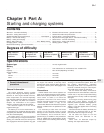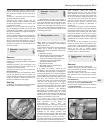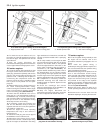
plugs. Use a timing light (paragraph 4 above)
to check whether HT voltage is present at all
leads.
13 If HT voltage is not present on any
particular lead, the fault will be in that lead or
in the distributor cap. If HT is present on all
leads, the fault will be in the spark plugs;
check and renew them if there is any doubt
about their condition.
14 If no HT is present, check the HT coil; its
secondary windings may be breaking down
under load.
Models with static
distributorless ignition systems
15 If a fault appears in the engine
management (fuel injection/ignition) system
first ensure that the fault is not due to a poor
electrical connection or poor maintenance; ie,
check that the air cleaner filter element is
clean, the spark plugs are in good condition
and correctly gapped, that the engine breather
hoses are clear and undamaged, referring to
Chapter 1 for further information. Also check
that the throttle cable is correctly adjusted as
described in the relevant part of Chapter 4. If
the engine is running very roughly, check the
compression pressures and the valve
clearances as described in Chapter 2B or 2C.
16 If these checks fail to reveal the cause of
the problem the vehicle should be taken to a
suitably equipped Peugeot dealer for testing.
A wiring block connector is incorporated in
the engine management circuit into which a
special electronic diagnostic tester can be
plugged. The tester will locate the fault quickly
and simply alleviating the need to test all the
system components individually which is a
time consuming operation that carries a high
risk of damaging the ECU.
17 The only ignition system checks which
can be carried out by the home mechanic are
those described in Chapter 1, relating to the
spark plugs, and the ignition coil test
described in this Chapter. If necessary, the
system wiring and wiring connectors can be
checked as described in Chapter 12 ensuring
that the ECU wiring connector(s) have first
been disconnected.
3 Ignition HT coil - removal,
testing and refitting
2
Note: On models with static distributorless
ignition systems, the ignition HT coil is an
integral part of the ignition module. Refer to
Section 6 for removal and refitting
procedures.
Removal
All engines except TU series
1 The ignition HT coil is located at the left-
hand side of the engine compartment mounted
on the side of the suspension strut tower.
2 Disconnect the battery negative lead.
3 Slide the cover off the coil and adjacent
ignition module (see illustration).
4 Disconnect the wiring at the coil LT
terminals, and the HT lead at the coil centre
terminal.
5 Release the coil mounting clamp and
remove the coil.
TU series engines
6 The ignition HT coil is mounted on the left-
hand end of the cylinder head, above the
distributor.
7 Disconnect the battery negative lead.
8 Refer to the relevant Part of Chapter 4 and
remove the air cleaner assembly. Once the air
cleaner is removed, move aside any pipes,
hoses or wiring as necessary for improved
access.
9 Where applicable, disconnect the wiring
connector from the capacitor mounted on the
coil mounting bracket and release the TDC
sensor wiring connector from the bracket.
10 Disconnect the HT lead from the coil then
depress the retaining clip and disconnect the
coil wiring connector (see illustration).
11 Slacken and remove the two retaining
bolts and remove the coil and mounting
bracket from the cylinder head. Where
necessary, slacken and remove the four
screws and nuts and separate the HT coil and
mounting bracket.
Testing
12 Testing of the coil consists of using a
multimeter set to its resistance function, to
check the primary (LT “+’“ to “-” terminals) and
secondary (LT “+” to HT lead terminal)
windings for continuity, bearing in mind that on
the four output, static type HT coil there are
two sets of each windings. Compare the
results obtained to those given in the
Specifications at the start of this Chapter. Note
the resistance of the coil windings will vary
slightly according to the coil temperature, the
results in the Specifications are approximate
values for when the coil is at 20°C.
13 Check that there is no continuity between
the HT lead terminal and the coil
body/mounting bracket.
14 If the coil is thought to be faulty, have your
findings confirmed by a Peugeot dealer before
renewing the coil.
Refitting (all models)
15 Refitting is a reversal of the relevant
removal procedure ensuring that the wiring
connectors are securely reconnected and,
where necessary, the HT leads are correctly
connected.
4 Distributor (breakerless
ignition systems) - removal
and refitting
2
Removal
All engines except TU series
1 Disconnect the battery negative lead.
2 Remove the air cleaner and/or inlet duct, as
necessary for access, with reference to the
relevant Part of Chapter 4.
3 Identify the HT leads for position then
disconnect them from the spark plugs.
4 Slide off the ignition coil cover and
disconnect the HT lead from the coil.
5 Pull back the plastic cover then unclip and
remove the distributor cap (see illustration).
Note that on certain later models the cap is
retained by two screws instead of clips.
6 Disconnect the wiring at the connector,
where necessary pulling out the spring clip
first.
7 Pull the hose from the vacuum advance
unit.
8 Mark the distributor mounting flange in
relation to the cylinder head or thermostat
housing as applicable.
Ignition system 5B•3
5B
3.3 On all engines except TU series,
access to the coil and ignition module is
gained after sliding up the protective cover
3.10 Disconnecting the coil wiring
connector (arrowed) on TU series engines
4.5 Pull back the plastic cover then unclip
and remove the distributor cap


















